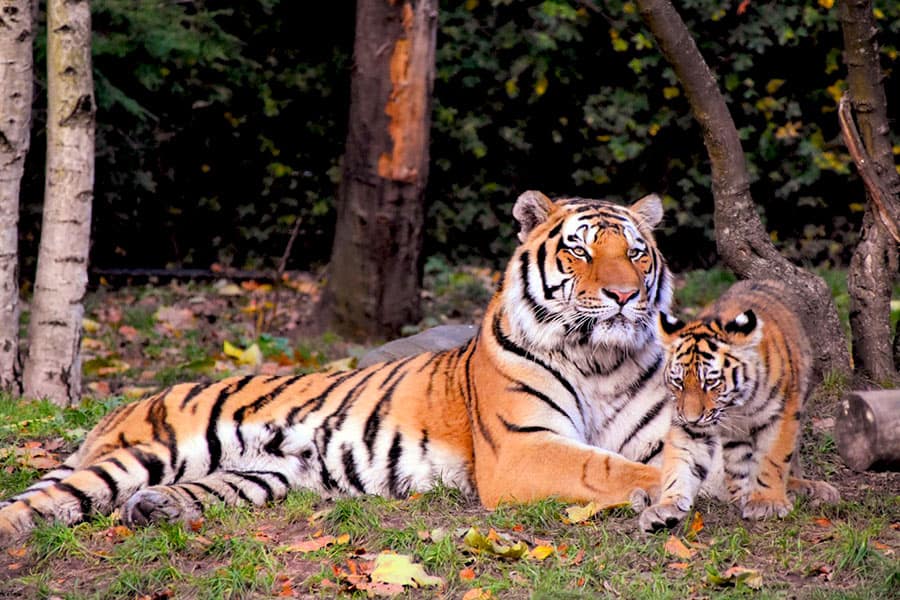Conservation of Endangered Tigers in 2021 is a top priority
Over a century ago, it is estimated that there were around 100,000 tigers living in the wild. In present day, approximations show that less than 4,000 tigers exist in the wild while around 8,000 live in captivity. Even though tigers were added to the Endangered Species of Wild Fauna and Flora in July of 1975, the tiger population has been steadily decreasing well into 2020. If we are to keep the species from extinction, it will take a worldwide commitment!
Specifications

Tigers are characterized by their orange and white coats that are covered in black stripes. It is said no two tigers have the same striped pattern, and the striped pattern goes down to their skin, not just their fur.
While there are 9 types of tiger subspecies, with 3 extinct, all tigers have the same characteristic colors except the rare white Bengal tigers and the Siberian tigers (Amur tiger), which have brown stripes instead of black.
In addition, these animals are the biggest cats in the world, with Siberian tiger males being able to weigh almost 700 pounds and being nearly eleven feet long from whiskers to the tip of their tails. The smallest subspecies, the Sumatran tiger, can weigh up to half the size of Siberian tigers.
Though their numbers are small, tiger natural habitats range from Bangladesh and Vietnam to Russia and India, and they are present in a total of 13 countries. In captivity, they can be found all over the world.
In the wild, tigers are solitary and typically hunt alone. Their diet mainly consists of mammals, such as deer, antelope, and wild boars, which are found in the dense forests and grasslands where tigers live. They can be opportunistic hunters as well and will feed on bears, birds, and sometimes elephants.
Their wide variety of meals also makes them integral parts of the ecosystems in which they live.
In addition to being aggressive hunters, tigers are also known for their impressive ability to swim great distances and will often lounge in streams and rivers on a hot day.
Endangerment and Extinction
Conservation of endangered tigers starts with the 9 subspecies of tigers, three have already gone extinct, all within recent history. All subspecies of tiger are classified as endangered. While the Bengal tiger is the most populated subspecies, they are still highly endangered.
The extinct Bali tiger was reportedly last seen in the 1930s, but they were not given the extinct status until the 1940s. Similarly, the Javan tiger, which was native to the Indonesian island, Java, was last seen in the 1970s and classified as extinct a decade later. Finally, the Caspian tiger, which were found in parts of Turkey and Iran, became extinct in the 1970s.
Endangered tigers face the same risks that made their cousins go extinct. Hunting and poaching as well as loss of habitat and prey due to human encroachment continue to affect the wild populations of tigers.
Tiger Conservation Efforts
According to the Wildlife Conservation Society, there are many efforts being put into conserving wild tiger populations. The key goal for sanctuaries and preserves is to protect tigers and their habitats from poachers and human encroachment. Designating land preserves specifically for endangered species can help reduce the chances of poaching and help prevent human/tiger conflicts.
In addition to these tiger conservation protections, the WCS plans to promote policies that are tiger friendly, conduct research on conservation strategies, and monitor wild tiger populations and threats. With these strategies, it’s possible to prevent further extinction of these beautiful creatures but conservation of endangered tigers will need a worldwide effort as many of the subspecies are listed as critically endangered.
Conservation of Endangered Tigers / Citations
https://www.livescience.com/29822-tiger-subspecies-images.html#:~:text=Amur%20tigers%20
http://www.animalplanet.com/wild-animals/tigerpedia/tiger-facts-prove-big-cats-amazing/
https://www.wcs.org/our-work/species/tigers
About Project Endangered Tigers
Project Endangered Tigers was born from the passionate desire of a grandfather to ensure that his granddaughters will inherit a world where tigers still exist in the wild. Project Endangered Tigers aims to spread awareness about the plight of the world’s last wild tigers while raising funds for their protection.
The Project consists of unique digital tiger products which keep tigers front and center in the digital realm while generating funds to protect them in the wild. Digital tiger products are paired with the website, which is home to up-to-date information on tigers, latest tiger news, and the specific conservation actions urgently needed to stop each sub-species from disappearing into extinction.
Save Tigers Live HD Wallpaper App & Screensaver
Screensaver and app sales benefit tiger conservation
WildCats Conservation Alliance is a wild tiger and Amur leopard initiative that funds carefully chosen conservation projects across Asia, working with a range of national and international conservation NGOs. It is a partnership between the Zoological Society of London (UK charity # 208728) and Dreamworld Wildlife Foundation (ACNC # 61150274463)’.
Screensaver Requirements
App Requirements





Once payment is made, you can download the screensaver and app immediately. The Android app can be downloaded directly from our website and includes a code to unlock the app. We have chosen not to include our app in the Google Play Store because of the very high fees Google charges.



